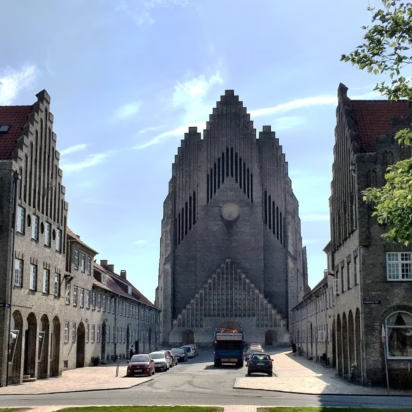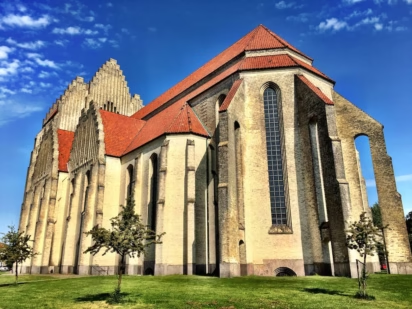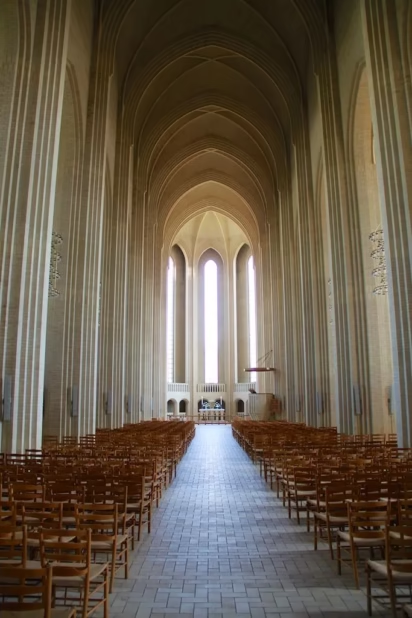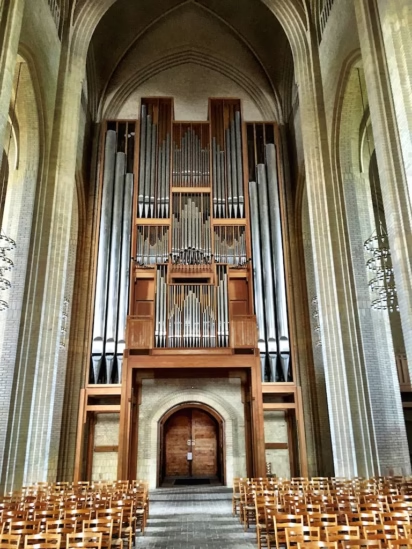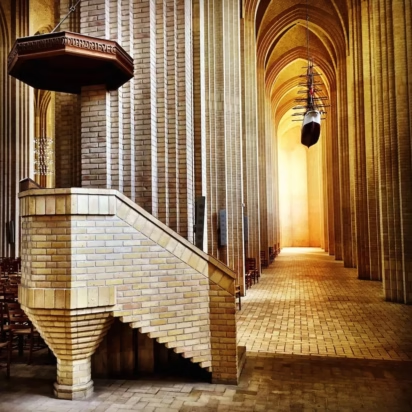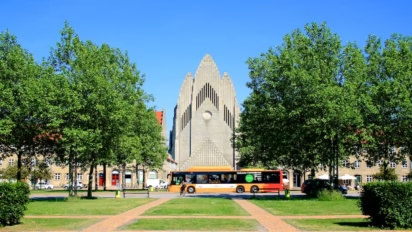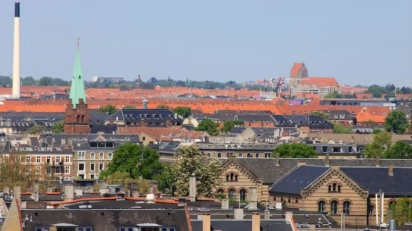The expressionist Grundtvigs Kirke combining brick gothic church architecture with modern style elements is a short bus ride from central Copenhagen.
The Grundtvig Memorial Church is one of the most famous churches in Copenhagen. It is a rare example of expressionist church architecture designed by Peder Vilhelm Jensen-Klint and built during the 1920s and 1930s. It combines the familiar brick Gothic architecture of Baltic Sea region churches with more modern style elements in a church of truly monumental proportions. The church is open for free and is easily reached by bus from central Copenhagen.
The Grundtvig’s Church on Bispebjerg in Copenhagen
The Grundtvigs Kirke honors the memory of the Danish priest, educator, and hymn writer N.F.S. Grundtvig (1783-1872).
The church was built in the 1920s as the focal point of a new residential district on the Bispebjerg Hill around 6 km to the northwest of central Copenhagen.
In relatively flat Copenhagen, a big church on a hill 31 m above sea level could be seen from the city center but nowadays this is only possible from higher buildings such as the Rundentaarn, Christiansborg, town hall tower, and Vor Frelser church spiral tower.
Jensen Klint’s Grundtvig’s Church
The Grundtvig’s Church in Copenhagen was designed by Peder Vilhelm Jensen Klint (1853 – 1930). He was inspired by the medieval rural churches in Denmark as well as the Gothic brick churches in Northern Germany and Scandinavia.
Jensen Klint combined style elements from these churches with more modern ideas into a rare example of expressionist church architecture. Using only humble bricks, he created a masterpiece of elegant simplicity and visual harmony. The simple numerical ratios and geometrical forms are a delight to architecture students.
However, the basic layout is that of a traditional Gothic church. A simple drawing of the floor plan will look very familiar to any medieval churchgoer: a western portal, triple nave and choir. The expressionist exterior is very much a modern update of the gothic designs but from the outside the hall and choir with typical red-tiled roof and flying buttresses are surprisingly conventional.
Construction of the Grundtvigs Kirke
Construction of the Grundtvig’s Church started in 1921 with the bell tower and the impressive western façade – the single aspect that this church is most famous for.
Klint was inspired by the stepped gables used on many churches in the region but raised the game: his westwork, resembling the pipes of a giant church organ, soars 49 m into the sky. The bell tower was inaugurated in 1927 with the original pulpit at the rear of the church still showing the small section that was in use until the completion of the main church.
The rest of the church was completed by Jensen Klint’s son, Kaare Klint (1888-1954), who is also often referred to as the father of modern Danish furniture design. (His son, Esben Klint, designed many of the interior fittings including the western organ and the chandeliers.)
The Grundtvig’s Church was inaugurated on 8 September 1940 while Denmark was under German occupation.
Dimensions of the Grundtvigs Kirke
The Grundtvig’s Church is not only monumental in appearance but also in size. This triple-aisle hall church has similar dimensions to the Copenhagen Cathedral: an internal length of 76 m, a full width of 35 m, and the Gothic vaulting 22 m high. The bell tower is 49 m high and the ridge of the roof covering the central nave is 30 m high.
Nearly 5 million light yellow bricks were used in the construction of the church. Each of the solid large pillars alone required around 32,000 bricks.
The interior of the Grundtvigs Kirke is a study in elegant simplicity. It is mostly lit through high plain-glass windows allowing the weather, time of day, and season to largely determine the mood.
Decorations and fittings are very limited. Most noticeably are the two organs by Marcussen & Son. The large western organ (1965) has 55 stops, four manuals and 4,052 pipes. The largest, weighing 425 kg, is at 11 m the longest organ pipe in Scandinavia. The smaller northern organ (1940) makes do with 14 stops and 2 manuals. (Dates of usually free organ concerts are posted at the door or website. The organ is played many Wednesdays at noon during a music service.)
Free organ concerts are often held in various churches in central Copenhagen, including the cathedral.
The four-masted bark “Queen Alexandrine” hanging in the south aisle is the largest model ship hanging in a church in Denmark. (The Sct. Mariæ Kirke in Helsingør also has some fine ships with a further example in the Holmenkirke in Copenhagen.)
The church currently sits 1440 visitors on simple chairs. The original configuration allowed for around 500 more.
Visiting the Grundtvigs Kirke in Copenhagen
The Grundtvig’s Church is usually open Monday to Saturday from 9:00 to 16:00 (closing at 18:00 on Thursday). On Sunday, the church is open for visitors from noon to 16:00 (13:00 during winter). Admission is free.
The church is not open for sightseeing during services: mass at 10:00 on Sundays, other ad hoc services possible without much prior notice.
The tower can only be climbed during occasional one-hour guided tours – free, but in Danish only.
Transportation to the Grundtvig’s Church in Copenhagen
Getting to the Grundtvigs Kirke, På Bjerget 14B, 2400 Copenhagen NV, tel. +45 35 81 54 42, is very easy from central Copenhagen. The simplest is on bus 6A: use stop Bispebjerg Torv (Zone 2, most central Copenhagen tickets and passes valid). (Alternatively, bus 4A from Nørrebro train and metro station.)
Bus 6A runs every 3 to 8 minutes from Nørreport station. Traveling time from Nørreport Station is around 15 minutes. The Grundtvig’s Church is marked on current bus maps handed out free on Copenhagen buses.
The Grundtvig’s Church was designed to be the focal point of a new planned neighborhood built for the working classes. The surrounding buildings thus use the same yellow brick and stepped gabled design that the expressionist church is famous for.
Other Churches in Copenhagen
Copenhagen has a large variety of churches ranging from the Gothic to modern. Organ concerts are often held with free performances common in the neo-classical cathedral (Vor Frue Kirke) with its Thorvaldsen statues, the gothic Trinitatiskirke with its Italian baroque organ (and Rundetårn viewing tower), or the baroque Vor Frelserskirke with its famous climbable spiral tower.

